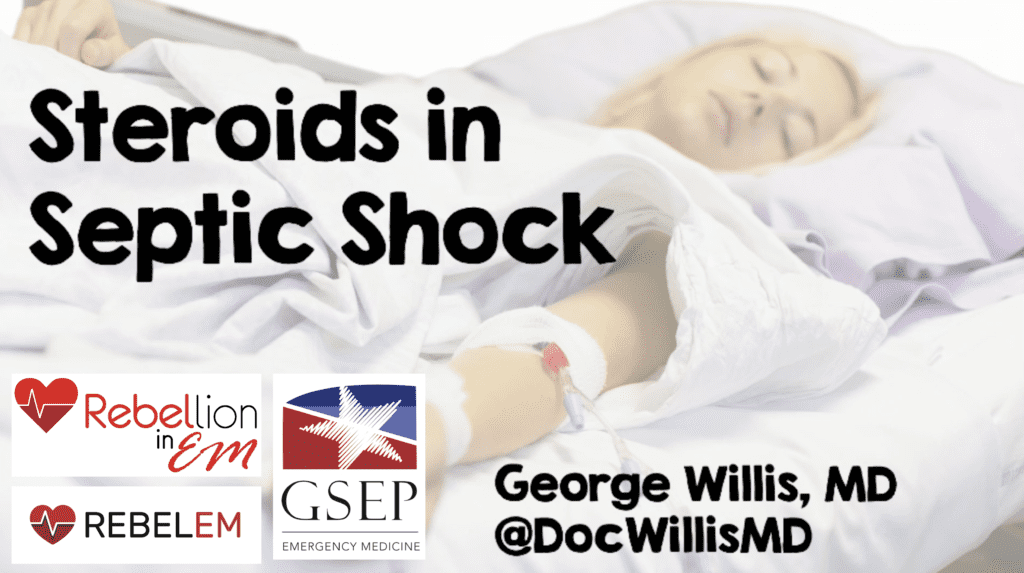
 “You’re in the emergency department, you have a patient who EMS has brought in from a nursing home…who’s excited? Right, nobody is. And they are brought in for a chief complaint of altered mental status. So they’re concerned about sepsis. This is your initial set of vital signs: febrile, tachycardic, hypotensive. And you’re looking at the patient and you’re looking at their Foley and it looks like somebody put oatmeal into it. You know for a fact that the probability is that they have a urinary tract infection is pretty high. So the next question is: do you do what you normally do, but add steroids?”
“You’re in the emergency department, you have a patient who EMS has brought in from a nursing home…who’s excited? Right, nobody is. And they are brought in for a chief complaint of altered mental status. So they’re concerned about sepsis. This is your initial set of vital signs: febrile, tachycardic, hypotensive. And you’re looking at the patient and you’re looking at their Foley and it looks like somebody put oatmeal into it. You know for a fact that the probability is that they have a urinary tract infection is pretty high. So the next question is: do you do what you normally do, but add steroids?”
Rebellion in EM 2019: Steroids in Septic Shock via George Willis, MD
[embedyt] https://www.youtube.com/watch?v=d3EysfT0lbA[/embedyt]
Also Be Sure to Checkout our YouTube Channel

Clinical Question:
We tend to think of sepsis as this kind of bag where we throw in fluids, vasopressors and antibiotics early so we can improve outcomes. Should steroids be included? What is the evidence that shows that steroids work in septic shock?
Background:
- Mineralocorticoids increase blood volume and help with vascular tone. Both effects would certainly be helpful in patients who are having increased permeability at the vascular level.
- Corticosteroids decrease pro-inflammatory cytokines while increasing anti-inflammatory cytokines. Effects that would certainly help with inflammation.
- Sepsis decreases the activity of the hypothalamic-pituitary-adrenal (HPA) axis. So there is thought to be a relative adrenal insufficiency, especially in severe septic shock. So steroids should help, theoretically.
Evidence:
- A study of 300 patients by Annane et. al. in 2002 compared the addition of hydrocortisone and fludrocortisone vs. placebo. In patients who were nonresponders to corticotropin stimulation, hydrocortisone and fludrocortisone for 7 days showed a decrease in mortality.1
- The CORTICUS study group in 2008 found that if you jumped on patients early with steroids, there were no benefits. However, these patients were thought to not be as sick. Maybe if we gave steroids to patients with sepsis that was more severe, we could prevent them from going into severe septic shock.2
- In the HYPRESS RCT, patients were given hydrocortisone before they went into septic shock. They didn’t find any benefit of steroids in preventing patients from developing severe septic shock.3
- The ADRENAL trial in 2018 looked at the effect of hydrocortisone in 3658 patients. They gave one group a hydrocortisone infusion of 200mg/day and they gave the other group placebo. They found no significant difference between the groups in terms of 90-day mortality. However, when assessing patient-centered outcomes they found: a) a faster resolution of shock and b) shorter duration of initial episode of mechanical ventilation.4
“So patient centered outcomes vs mortality, there’s a conundrum, what do we do. What are we basing our treatment off of? This study really showed that there was no real harm to giving steroids, there’s just no difference in terms of mortality. There is a caveat to this, the study actually said you had to give a 200mg/day as an infusion, as opposed to typical stress dose steroids of 100mg q8hrs. Someone said well, maybe the ADRENAL study isn’t the end-all-be-all.”
Enter the APROCCHSS study: This study looked at fludrocortisone, hydrocortisone, and activated protein C vs. placebo. When activated protein C was withdrawn from the market for safety concerns, they continued the study with two groups: one received hydrocortisone plus fludrocortisone and the other received placebo. They studied 1241 patients and found that 90-day mortality was significantly lower in the hydrocortisone plus fludrocortisone group. Additionally, other outcomes were also positive: more vasopressor-free days and organ-failure-free days. In this study, the number of ventilator-free days was similar between the two groups.5
“But again there are caveats:
- The addition of fludrocortisone. There was no comparison between hydrocortisone and fludrocortisone, it was just both vs placebo.
- Fludrocortisone doses used was 50µg, which is a really low dose.”
Although the mortality benefit is questionable, when considering patient-centered outcomes, there is potential utility. It is undeniable that we want our patients to have a faster reversal of shock, less days on a ventilator, less days on pressors and less days in the ICU.
Conclusion:
“I say: certainly, if the patient has risk of adrenal insufficiency due to chronic steroid therapy, it’s a no brainer, make it happen. If the patient is requiring multiple doses of pressors, you’re starting to max out your norepinephrine and you’re starting to think maybe I should add a second or third pressor. In order to get them off of those pressors faster and out of shock, I would give them a stress dose of steroids. And I am using hydrocortisone and not fludrocortisone.”
References:
- Annane D et al. Effect of Treatment with Low Doses of Hydrocortisone and Fludrocortisone on Mortality in Patients with Septic Shock. JAMA 2002. PMID: 12186604
- Sprung C et al. Hydrocortisone Therapy for Patients with Septic Shock. NEJM 2008. PMID: 18184957
- Keh D et al. Effect of Hydrocortisone on Development of Shock Among Patients with Severe Sepsis: The HYPRESS Randomized Clinical Trial. JAMA 2016. PMID: 27695824
- Venkatesh B et. al. Adjunctive Glucocorticoid Therapy in Patients with Septic Shock. NEJM 2018. PMID: 29347874
- Annane D et. al. Hydrocortisone plus Fludrocortisone for Adults with Septic Shock. NEJM 2018. PMID: 29490185
For More Thoughts on This Topic Checkout:
- REBEL EM: The ADRENAL Trial – Steroids in Septic Shock
- REBEL EM: APROCCHSS – More on Steroids in Septic Shock
- REBEL EM: Should We Pump Up the Juice (Steroids) in Septic Shock?
- REBEL EM: The HYPRESS Trial – Early Steroids to Prevent Septic Shock
Transcript/Summary By: Yasien Eltigani, MS4 at St. George’s University (@yasieneltigani)
Post Peer Reviewed By: Salim R. Rezaie, MD (Twitter: @srrezaie)
The post Steroids in Septic Shock via George Willis, MD appeared first on REBEL EM - Emergency Medicine Blog.
